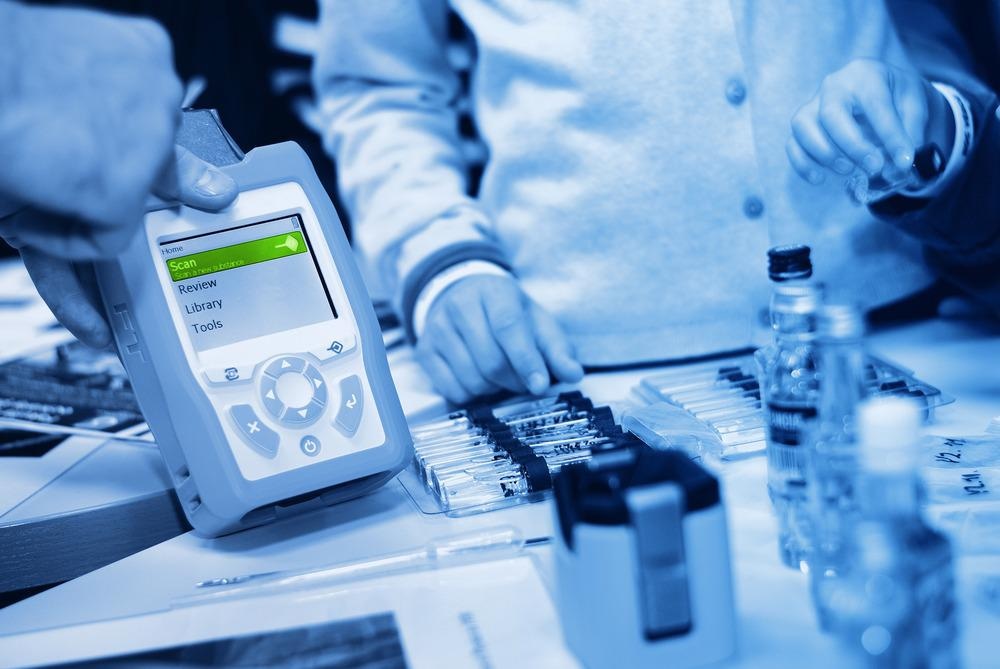
Image Credit: Forance/Shutterstock.com
Significant advancements in Raman spectroscopy techniques that have been achieved in recent years have facilitated the development of Raman spectroscopy for a variety of biomedical applications. In particular, the establishment of spatially offset Raman spectroscopy (SORS) methods, which has increased the depth at which living tissue can be probed to as much as 5 cm (an increase of two orders of magnitude compared to the capabilities of traditional Raman spectroscopy), has helped to further the use of the technology in the analysis of biological tissues.
As a result, a vast range of potential new applications for Raman spectroscopy has opened up, particularly in the biomedical sector. These include diagnostics and disease monitoring, such as providing methods of non-invasive methods of cancer diagnosis, monitoring of neurotransmitters, and assessment techniques for bone disease.
Here, we discuss the recent developments in this field and predict what future developments may hold.
The Growing Number of Biomedical Applications of Raman Spectroscopy
Raman spectroscopy techniques have long been relied upon for collecting high-quality quantitative and quantitative data. Scientists use these methods to access vital information quickly and easily.
Raman spectroscopy has been adopted in several fields for conducting a wide range of analyses. It can be used to characterize chemical compositions and structures of samples in all states (solid, liquid, and gas, including gel, slurry, and powder).
Recent years have seen the technique adapted to study biological tissues both in vivo and in vitro. It has already successfully been adopted by scientists to establish methods of early detection of cancer, monitoring the impact of compounds on the skin, ascertaining the composition of atherosclerotic plaque, and identification of pathogenic microorganisms.
Numerous technological advancements have supported the establishment of Raman spectroscopy in these fields, such as innovations in CCD detectors, lasers, and fiber-optic probes. Here, we will discuss these various advancements and how they have propelled Raman spectroscopy in biomedical applications.
Assessment of blood quality
One of the first applications of the “surface-enhanced spatially offset Raman spectroscopy” (SESORS) technique, a variation of Raman spectroscopy, was in measuring blood glucose levels in vivo. The method offers a non-invasive approach to monitoring blood-glucose levels, which is particularly useful to those with diabetes who must monitor these levels daily. In addition, the approach can be used to measure other blood-related factors, such as performing quality assessments of red blood cells prior to patient transfusion.
Usually, blood donations can only be stored for a total of 42 days due to biochemical changes that occur over time, resulting in the blood no longer being safe for transfusions.
SESORS is being used to expand this time frame by offering a method of profiling levels of oxygenation during this storage period. It also allows scientists to gain a more detailed picture of the blood’s quality, which does not always correlate with the age of the sample. The SESORS method allows scientists to measure the red blood cell quality of a sample before it is used for transfusion, without damaging it.
Assessment of bone diseases
The current standard for the measurement of bone density is the implementation of dual X-ray absorptiometry (DXA), a technique that identifies and measures areas of low bone mass to help highlight patients who may be at increased risk of fractures.
However, this approach is not without its limitations as studies have shown DXA to be less reliable at indicating low bone mass in certain populations, e.g. early postmenopausal women. Additionally, DXA cannot measure collagen, bone’s main organic compound, resulting in roughly 30-40% of fracture risks going undetected.
The alternative method of quantitative CR can be used to overcome the limitations of DXA, however, it has its own drawbacks of being expensive and exposing patients to higher levels of radiation.
Spatially offset Raman spectroscopy (SORS) has been developed as a non-invasive method of assessing osteoporosis and other bone disorders. The method is low cost, lacks ionizing radiation, and can provide data on the inorganic and organic components of bone, making it a promising alternative.
Cancer diagnostics
SORS has also been developed as a non-invasive technique of detecting and characterizing cancer. Studies have shown that Raman spectroscopy is successful in identifying the chemical differences that exist between benign and malignant microcalcifications in breast cancer. SORS has been developed to identify these calcifications at the depths that are required to be clinically relevant.
Future Directions
In the near future, it can be expected that applications of SORS and SESORS will be well established in bone disease, neurotransmitters, and cancer fields. In addition, it is predicted that applications of these Raman spectroscopy technologies will expand out of these therapy areas, with a particular focus on the development of SESORS for molecular imaging. Much of these advancements, however, will be dependent on the approval of these techniques by various governing bodies, such as the Food and Drug Administration (FDA).
References and Further Reading
Choo-Smith, L., Edwards, H., Endtz, H., Kros, J., Heule, F., Barr, H., Robinson, J., Bruining, H. and Puppels, G., 2002. Medical applications of Raman spectroscopy: From proof of principle to clinical implementation. Biopolymers, 67(1), pp.1-9. https://pubmed.ncbi.nlm.nih.gov/11842408/
Nicolson, F., Kircher, M., Stone, N. and Matousek, P., 2021. Spatially offset Raman spectroscopy for biomedical applications. Chemical Society Reviews, 50(1), pp.556-568. https://pubs.rsc.org/hy/content/articlehtml/2021/cs/d0cs00855a
Stone, N., Baker, R., Rogers, K., Parker, A. and Matousek, P., 2007. Subsurface probing of calcifications with spatially offset Raman spectroscopy (SORS): future possibilities for the diagnosis of breast cancer. The Analyst, 132(9), p.899. https://pubs.rsc.org/en/content/articlelanding/2007/AN/B705029A
Disclaimer: The views expressed here are those of the author expressed in their private capacity and do not necessarily represent the views of AZoM.com Limited T/A AZoNetwork the owner and operator of this website. This disclaimer forms part of the Terms and conditions of use of this website.